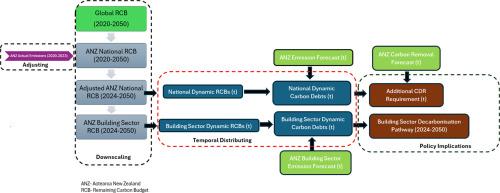Dynamic carbon budgets and carbon debts for Aotearoa New Zealand and its building sector
IF 7.6
1区 工程技术
Q1 CONSTRUCTION & BUILDING TECHNOLOGY
引用次数: 0
Abstract
The remaining carbon budget (RCB) is a crucial parameter when setting climate budgets for nations and economic sectors that want to measure their progress in climate change mitigation. The Paris Agreement is the most widely used and accepted climate change mitigation target, and the global RCB specified by the Intergovernmental Panel for Climate Change (IPCC) provides the carbon budget remaining from the beginning of 2020 that can be emitted as CO2 before the Paris Agreement’s target is exceeded. This research investigates the global RCB allocation to the national and building sector level in Aotearoa New Zealand, including consideration of different sharing approaches and modelling of potential future dynamic parameters for the RCB allocation, that are required to stay below 1.5 °C warming between the years 2024 and 2050. The average national RCB ranges from 159 to 339 MtCO₂ from year 2024; based on an average annual emissions rate of 38 MtCO₂, it will be depleted in 4–8 years. Therefore, this study proposed a dynamic carbon debt framework that provides a more realistic representation of dynamic RCBs and the carbon debt over future years. Key findings include the urgency of timely interventions, the need for additional mitigation strategies beyond the current policy approach which is largely focused on increased plantation forestry, and the usefulness of time-disaggregated carbon budgeting to address exhaustion of the RCB. Overall, this study demonstrates the relevance of dynamic budgeting to guide effective climate policy at both the national and building sector levels.

新西兰及其建筑部门的动态碳预算和碳债务
在为希望衡量其减缓气候变化进展的国家和经济部门制定气候预算时,剩余碳预算(RCB)是一个关键参数。《巴黎协定》是最广泛使用和接受的气候变化减缓目标,政府间气候变化专门委员会(IPCC)规定的全球RCB提供了从2020年初起剩余的碳预算,在超过《巴黎协定》目标之前,这些预算可以作为二氧化碳排放。本研究调查了新西兰奥特罗阿国家和建筑部门层面的全球可再生能源分配情况,包括考虑不同的共享方法和对可再生能源分配的潜在未来动态参数的建模,这些参数要求在2024年至2050年间保持在1.5°C以下。从2024年开始,全国平均RCB范围为159 - 3.39亿吨二氧化碳;以年均3800万吨co₂的排放量为标准,将在4 ~ 8年内耗尽。因此,本研究提出了一个动态碳债框架,该框架提供了未来几年动态rcb和碳债的更现实的表示。主要结论包括:迫切需要及时采取干预措施,需要在目前主要侧重于增加人工林的政策方针之外制定更多的缓解战略,以及按时间分列的碳预算对解决RCB用尽问题的有用性。总体而言,本研究证明了动态预算在国家和建筑部门层面指导有效气候政策的相关性。
本文章由计算机程序翻译,如有差异,请以英文原文为准。
求助全文
约1分钟内获得全文
求助全文
来源期刊

Building and Environment
工程技术-工程:环境
CiteScore
12.50
自引率
23.00%
发文量
1130
审稿时长
27 days
期刊介绍:
Building and Environment, an international journal, is dedicated to publishing original research papers, comprehensive review articles, editorials, and short communications in the fields of building science, urban physics, and human interaction with the indoor and outdoor built environment. The journal emphasizes innovative technologies and knowledge verified through measurement and analysis. It covers environmental performance across various spatial scales, from cities and communities to buildings and systems, fostering collaborative, multi-disciplinary research with broader significance.
 求助内容:
求助内容: 应助结果提醒方式:
应助结果提醒方式:


